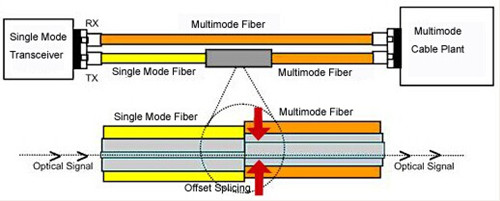Wavelength as we have been heard so many times in fiber optics, is not simply the term used to refine the color of the light. The light used in fiber optics in not the one that we can see by our eyes, as we use light in the infrared region which has wavelengths longer than visible light, typically around 850 nm, 1300 nm, 1550 nm. So why do we use infrared region? Why is 1550nm the most widely used wavelength in optical communication systems? What will happen if I transmit 850nm signal through a 1300nm optical fiber? This post has collected frequently asked questions about wavelength in fiber optics and provides the solutions to them, respectively.

As we known that light is defined by its wavelength, namely it is a member of the frequency spectrum, and each frequency (sometimes also called color) of light has a wavelength associated with it. Wavelength and frequency are related, generally, the radiation of shorter wavelengths like light, UV and X-rays are identified by their wavelengths, while the longer wavelengths like radio, TV and microwaves are identified by their frequency. Wavelengths typically range from 800 nm to 1600 nm, but by far the most common wavelengths actually used in fiber optics are 850 nm, 1300 nm, and 1550 nm.
Why do we use the fiber in 850nm, 1310nm and 1550nm wavelength?
In genera, fiber optic transmission wavelengths are determined by two factors: less fiber loss and absorption. The light we can see is in the range of about 400 nm to 700 nm, from blue/violet to the red, but the light used in fiber optics is at longer wavelength around 850, 1300, 1550 nm. This is because the attenuation of the fiber is less at longer wavelengths, which will result in less fiber loss. What’s more, the absorption usually does not occur in this wavelength.

From the chart below, we can obviously see that there are three low-lying areas of absorption, and an ever-decreasing amount of scattering as wavelengths increase. As you can see, all three popular wavelengths have almost zero absorption.
Why is 1550 nm the most widely used wavelength in optical communication systems?
The answer is simple: central wavelength of 1550 nm around C-band (1525-1565 nm) is popularly known as zero loss window, means silica fiber gives least attenuation at this wavelength about 0.2 dB/km, moreover, EDFA provides second largest peak gain (first is at 1530 nm) at 1550 nm, this makes overall double benefit to use 1550 nm as information signal wavelength.
What will happen if I transmit 850nm signal through a 1300nm optical fiber?
Most 1300nm optical fiber systems use single mode fiber. Most 850nm optical fiber systems use multimode fiber. Therefore, typical 850nm transmitters are designed to couple into multimode fiber. Coupling into multimode fiber only requires focusing the light down onto a spot about 50 um in diameter. Single mode fiber patch cables, on the other hand, typically have a core diameter of about 9 um.

Because of this, practically, if you take an off-the-shelf 850-nm transmitter and attach it to a typical fiber meant to be used for 1300 nm, the coupling efficiency will be very poor and only a small fraction of the tranmitter's power will reach the receiver. Of course it's possible to design an 850nm transmitter for coupling to 9um fiber. If you use the mode conditional patch cable, then the main limitation would be that Rayleigh scattering losses increase for shorter wavelengths, so the fiber will have more attenuation for the 850-nm light.
Why not use 1550nm all the time?
Since operating at 1550nm provides the best performance, it seems logical to choose 1550nm for every link. However, a major part of the link cost is the laser. Lasers operating at 1550nm are more difficult to manufacture than those at 1310nm and consequently are more expensive. Therefore shorter links (up to 10km) would typically use a 1310nm laser because it provides good performance at a lower cost. Longer link distances (10-100km) where losses become more critical to performance would typically use the higher cost 1550nm laser since these link lengths are not feasible with the fiber losses which occur at 1310nm.
Conclusion
To sum up, since the attenuation of the wavelengths at 850 nm, 1300 nm, and 1550 nm are relatively less, they are the most three common wavelengths used in fiber optic communication. Of which 1550nm is the most commonly used wavelength in fiber optics. FS.COM offers a full range of multimode and single mode fiber optic cables and transceivers which operate on different wavelength. Our custom fiber patch cords provides flexibility and performance for today’s high density applications.
评论
发表评论